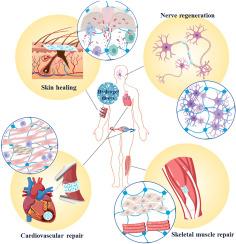Biomimetic hydrogel micro-/nanofibers for in situ soft tissue repair and regeneration
IF 18
1区 医学
Q1 ENGINEERING, BIOMEDICAL
引用次数: 0
Abstract
To effectively harness the regenerative potential of the body and orchestrate cellular responses for in situ tissue repair, the design of biomaterials requires careful consideration of precise modulation of biophysical and biochemical cues. This is essential to maximize the guidance of endogenous cell responses at the injury site. Hydrogel micro-/nanofibers, which integrate the benefits of hydrogel biomaterials and micro-/nanofiber architectures into a unified scaffold, have emerged as innovative biomimetic substrates that closely mimic the physiological characteristics of native extracellular matrix. These substrates exhibit tissue-like polymer networks, rapid responsiveness to microenvironmental changes, and permeability to essential nutrients and oxygen. Their biomimetic attributes facilitate cell recruitment and diffusion for angiogenesis, nutrient diffusion for cell self-renewal, and cell-material interactions for matrix remodeling, thus effectively harnessing the regenerative capacity of the body for tissue-specific regeneration. This review offers an overview of recent advances in hydrogel micro-/nanofiber design and their applications in in situ soft tissue engineering, focusing on: I) the concept and biomimetic characteristics of hydrogel micro-/nanofibers; II) current fabrication strategies, including material selection and preparation methods; and III) research progress in employing hydrogel micro-/nanofibers for in situ soft tissue regeneration, particularly in nerve, skin, cardiovascular, and skeletal muscle tissues. Overall, leveraging the body's regenerative potential through biomimetic hydrogel micro-/nanofibers represents an effective and promising approach for restoring damaged tissues. Additionally, this review provides valuable insights to foster interdisciplinary knowledge exchange and enables the development of prognostic markers for the next generation of hydrogel micro-/nanofibers to accelerate soft tissue regeneration.

用于软组织原位修复和再生的仿生水凝胶微/纳米纤维
为了有效地利用身体的再生潜能和协调细胞反应进行原位组织修复,生物材料的设计需要仔细考虑生物物理和生化信号的精确调节。这对于最大限度地引导损伤部位的内源性细胞反应是必不可少的。水凝胶微/纳米纤维将水凝胶生物材料和微/纳米纤维结构的优点整合到一个统一的支架中,已经成为一种创新的仿生基质,它密切模仿了天然细胞外基质的生理特性。这些基质表现出类似组织的聚合物网络,对微环境变化的快速反应,以及对必需营养物质和氧气的渗透性。它们的仿生特性有助于血管生成的细胞招募和扩散,细胞自我更新的营养物质扩散,以及基质重塑的细胞-物质相互作用,从而有效地利用身体的再生能力进行组织特异性再生。本文综述了近年来水凝胶微/纳米纤维的设计及其在原位软组织工程中的应用,主要包括:1)水凝胶微/纳米纤维的概念和仿生特性;II)当前的制造策略,包括材料选择和制备方法;水凝胶微/纳米纤维用于软组织原位再生的研究进展,特别是在神经、皮肤、心血管和骨骼肌组织中的应用。总之,利用人体的再生潜力,通过仿生水凝胶微/纳米纤维是修复受损组织的有效和有前途的方法。此外,本综述为促进跨学科知识交流提供了有价值的见解,并为下一代水凝胶微/纳米纤维的预后标志物的开发提供了可能,以加速软组织再生。
本文章由计算机程序翻译,如有差异,请以英文原文为准。
求助全文
约1分钟内获得全文
求助全文
来源期刊

Bioactive Materials
Biochemistry, Genetics and Molecular Biology-Biotechnology
CiteScore
28.00
自引率
6.30%
发文量
436
审稿时长
20 days
期刊介绍:
Bioactive Materials is a peer-reviewed research publication that focuses on advancements in bioactive materials. The journal accepts research papers, reviews, and rapid communications in the field of next-generation biomaterials that interact with cells, tissues, and organs in various living organisms.
The primary goal of Bioactive Materials is to promote the science and engineering of biomaterials that exhibit adaptiveness to the biological environment. These materials are specifically designed to stimulate or direct appropriate cell and tissue responses or regulate interactions with microorganisms.
The journal covers a wide range of bioactive materials, including those that are engineered or designed in terms of their physical form (e.g. particulate, fiber), topology (e.g. porosity, surface roughness), or dimensions (ranging from macro to nano-scales). Contributions are sought from the following categories of bioactive materials:
Bioactive metals and alloys
Bioactive inorganics: ceramics, glasses, and carbon-based materials
Bioactive polymers and gels
Bioactive materials derived from natural sources
Bioactive composites
These materials find applications in human and veterinary medicine, such as implants, tissue engineering scaffolds, cell/drug/gene carriers, as well as imaging and sensing devices.
 求助内容:
求助内容: 应助结果提醒方式:
应助结果提醒方式:


